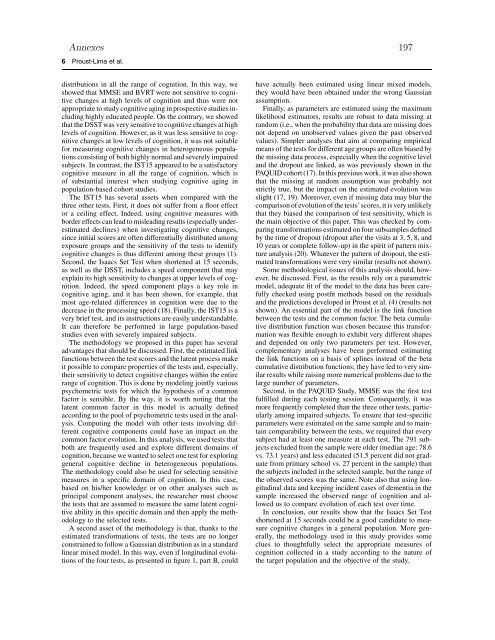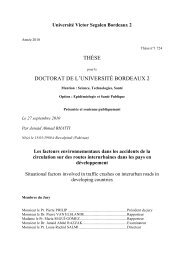Télécharger le texte intégral - ISPED-Enseignement à distance
Télécharger le texte intégral - ISPED-Enseignement à distance
Télécharger le texte intégral - ISPED-Enseignement à distance
- No tags were found...
Create successful ePaper yourself
Turn your PDF publications into a flip-book with our unique Google optimized e-Paper software.
Annexes 1976 Proust-Lima et al.distributions in all the range of cognition. In this way, weshowed that MMSE and BVRT were not sensitive to cognitivechanges at high <strong>le</strong>vels of cognition and thus were notappropriate to study cognitive aging in prospective studies includinghighly educated peop<strong>le</strong>. On the contrary, we showedthat the DSSTwas very sensitive to cognitive changes at high<strong>le</strong>vels of cognition. However, as it was <strong>le</strong>ss sensitive to cognitivechanges at low <strong>le</strong>vels of cognition, it was not suitab<strong>le</strong>for measuring cognitive changes in heterogeneous populationsconsisting of both highly normal and severely impairedsubjects. In contrast, the IST15 appeared to be a satisfactorycognitive measure in all the range of cognition, which isof substantial interest when studying cognitive aging inpopulation-based cohort studies.The IST15 has several assets when compared with thethree other tests. First, it does not suffer from a floor effector a ceiling effect. Indeed, using cognitive measures withborder effects can <strong>le</strong>ad to mis<strong>le</strong>ading results (especially underestimateddeclines) when investigating cognitive changes,since initial scores are often differentially distributed amongexposure groups and the sensitivity of the tests to identifycognitive changes is thus different among these groups (1).Second, the Isaacs Set Test when shortened at 15 seconds,as well as the DSST, includes a speed component that mayexplain its high sensitivity to changes at upper <strong>le</strong>vels of cognition.Indeed, the speed component plays a key ro<strong>le</strong> incognitive aging, and it has been shown, for examp<strong>le</strong>, thatmost age-related differences in cognition were due to thedecrease in the processing speed (18). Finally, the IST15 is avery brief test, and its instructions are easily understandab<strong>le</strong>.It can therefore be performed in large population-basedstudies even with severely impaired subjects.The methodology we proposed in this paper has severaladvantages that should be discussed. First, the estimated linkfunctions between the test scores and the latent process makeit possib<strong>le</strong> to compare properties of the tests and, especially,their sensitivity to detect cognitive changes within the entirerange of cognition. This is done by modeling jointly variouspsychometric tests for which the hypothesis of a commonfactor is sensib<strong>le</strong>. By the way, it is worth noting that thelatent common factor in this model is actually definedaccording to the pool of psychometric tests used in the analysis.Computing the model with other tests involving differentcognitive components could have an impact on thecommon factor evolution. In this analysis, we used tests thatboth are frequently used and explore different domains ofcognition, because we wanted to se<strong>le</strong>ct one test for exploringgeneral cognitive decline in heterogeneous populations.The methodology could also be used for se<strong>le</strong>cting sensitivemeasures in a specific domain of cognition. In this case,based on his/her know<strong>le</strong>dge or on other analyses such asprincipal component analyses, the researcher must choosethe tests that are assumed to measure the same latent cognitiveability in this specific domain and then apply the methodologyto the se<strong>le</strong>cted tests.A second asset of the methodology is that, thanks to theestimated transformations of tests, the tests are no longerconstrained to follow a Gaussian distribution as in a standardlinear mixed model. In this way, even if longitudinal evolutionsof the four tests, as presented in figure 1, part B, couldhave actually been estimated using linear mixed models,they would have been obtained under the wrong Gaussianassumption.Finally, as parameters are estimated using the maximumlikelihood estimators, results are robust to data missing atrandom (i.e., when the probability that data are missing doesnot depend on unobserved values given the past observedvalues). Simp<strong>le</strong>r analyses that aim at comparing empiricalmeans of the tests for different age groups are often biased bythe missing data process, especially when the cognitive <strong>le</strong>veland the dropout are linked, as was previously shown in thePAQUID cohort (17). In this previous work, it was also shownthat the missing at random assumption was probably notstrictly true, but the impact on the estimated evolution wasslight (17, 19). Moreover, even if missing data may blur thecomparison of evolution of the tests’scores, it is very unlikelythat they biased the comparison of test sensitivity, which isthe main objective of this paper. This was checked by comparingtransformations estimated on four subsamp<strong>le</strong>s definedby the time of dropout (dropout after the visits at 3, 5, 8, and10 years or comp<strong>le</strong>te follow-up) in the spirit of pattern mixtureanalysis (20). Whatever the pattern of dropout, the estimatedtransformations were very similar (results not shown).Some methodological issues of this analysis should, however,be discussed. First, as the results rely on a parametricmodel, adequate fit of the model to the data has been carefullychecked using postfit methods based on the residualsand the predictions developed in Proust et al. (4) (results notshown). An essential part of the model is the link functionbetween the tests and the common factor. The beta cumulativedistribution function was chosen because this transformationwas f<strong>le</strong>xib<strong>le</strong> enough to exhibit very different shapesand depended on only two parameters per test. However,comp<strong>le</strong>mentary analyses have been performed estimatingthe link functions on a basis of splines instead of the betacumulative distribution functions; they have <strong>le</strong>d to very similarresults whi<strong>le</strong> raising more numerical prob<strong>le</strong>ms due to thelarge number of parameters.Second, in the PAQUID Study, MMSE was the first testfulfil<strong>le</strong>d during each testing session. Consequently, it wasmore frequently comp<strong>le</strong>ted than the three other tests, particularlyamong impaired subjects. To ensure that test-specificparameters were estimated on the same samp<strong>le</strong> and to maintaincomparability between the tests, we required that everysubject had at <strong>le</strong>ast one measure at each test. The 791 subjectsexcluded from the samp<strong>le</strong> were older (median age: 78.6vs. 73.1 years) and <strong>le</strong>ss educated (51.5 percent did not graduatefrom primary school vs. 27 percent in the samp<strong>le</strong>) thanthe subjects included in the se<strong>le</strong>cted samp<strong>le</strong>, but the range ofthe observed scores was the same. Note also that using longitudinaldata and keeping incident cases of dementia in thesamp<strong>le</strong> increased the observed range of cognition and allowedus to compare evolution of each test over time.In conclusion, our results show that the Isaacs Set Testshortened at 15 seconds could be a good candidate to measurecognitive changes in a general population. More generally,the methodology used in this study provides someclues to thoughtfully se<strong>le</strong>ct the appropriate measures ofcognition col<strong>le</strong>cted in a study according to the nature ofthe target population and the objective of the study.
















